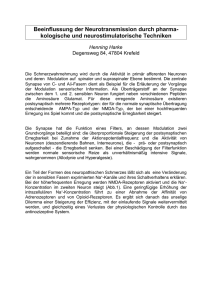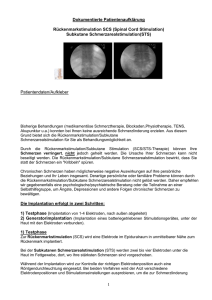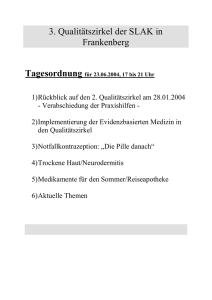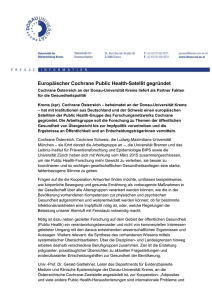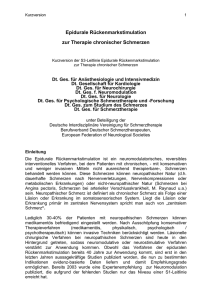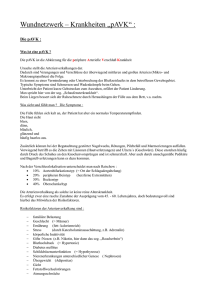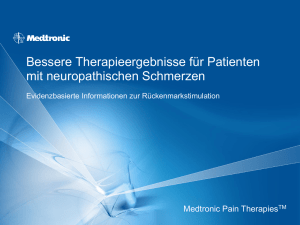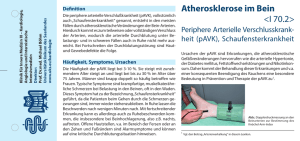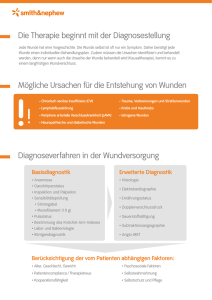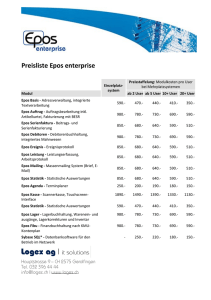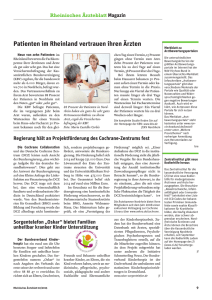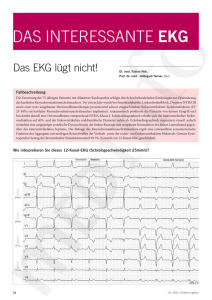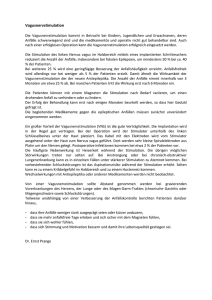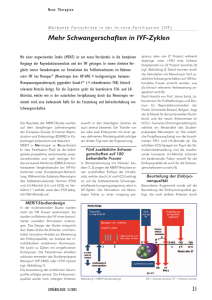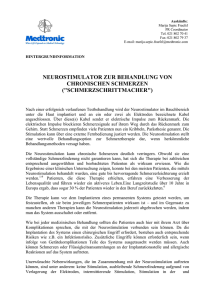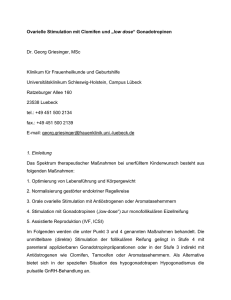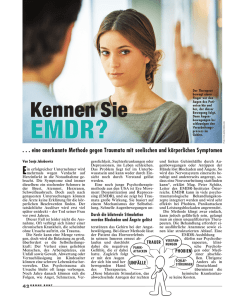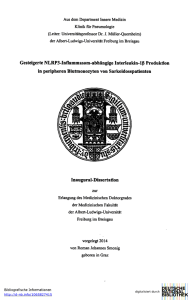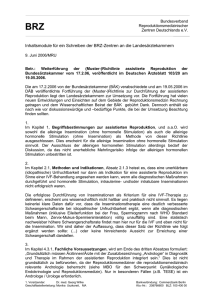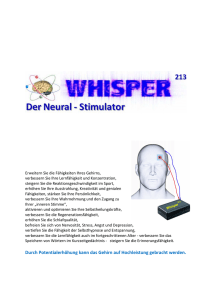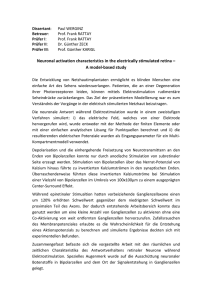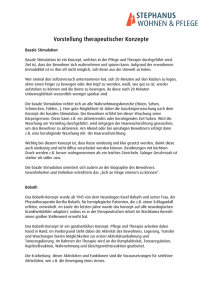PowerPoint-Präsentation
Werbung
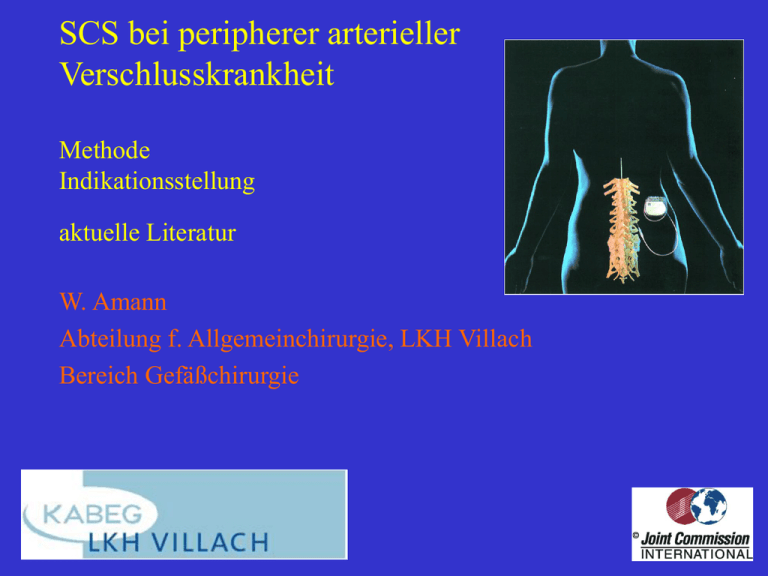
SCS bei peripherer arterieller Verschlusskrankheit Methode Indikationsstellung aktuelle Literatur W. Amann Abteilung f. Allgemeinchirurgie, LKH Villach Bereich Gefäßchirurgie Geschichte • 1965: Melzack et Wall: Gate Control Theory • 1967: Shealy et al:Dorsal Column Stimulation (DCS) based on Gate Control Theory • 1976: Cook et al: Electrical stimulation of spinal cord in vascular disease • seit 1998: SCS bei PAVK in Österreich ( Graz, Innsbruck und Villach ) SCS - Wirkmechanismus bei PAVK Antidrome Aktivierung von primär afferenten Nervenfasern Hemmung des Schmerzsignals verminderte sympathische Aktivität Freisetzung von vasoaktiven Substanzen Vasodilatation Modulation von autonomen Steuerungsprozessen Schmerzreduktion Linderoth et al. Freisetzen von vasoaktiven Substanzen Problempatient 1- PAVK mit bedrohter Extremität Stadium III und IV nach Fontaine 2 - technische Inoperabilität 3 - fehlende Op- Tauglichkeit ( Begleiterkrankungen ) 4 - konservative Therapie nicht ausreichend Kriterien der technischen Inoperabilität • PAVK - peripherer Verschlußtyp • schlechter distaler Abstrom • fehlende distale Anschlußmöglichkeit • keine geeignete autologe Transplantatvene Eingriff Operativer Ablauf Platzierung der Sonde Postoperative Stimulierung Programmierung des Impulsgebers mit N-Vision ( OP oder Krankenbett) ESES Study Klomp HM , Spincemaille GHJJ, Steyerberg EW, Habbema JDF, van Urk H, for the ESES study group: Spinal - cord stimulation in critical limb ischemia: a randomised trial. ESES Study Group. Lancet 1999; 353: 1040-1044 ESES Study - Design • Prospektive randomisierte kontrollierte Multicenterstudie • 17 holländische Zentren • Nov 1991 bis Jan 1996 ESES Study - Methode • Patienten mit nicht rekonstruierbarer chron. PAVK III-IV • 120 Patienten • Randomisierung in 2 Therapiearme ( jeder 60 Pt ) – SCS zusätzlich zu „best medical treatment“ ( lokale Wundtherapie Medikation inkl.Schmerztherapie, Antikoagulation, vasoactive Therapie, Antibiotika ) – „best medical treatment“ allein ESES Study - Endpunkte • Primärer Endpunkt – Beinerhalt ( definiert als „keine Major Amputation“ ) • Sekundäre Endpunkte – – – – Schmerzreduktion Analgetikaverbrauch Lebensqualitiät Kostenanalyse ESES Ergebnisse • Positiver Effekt auf Schmerzreduktion und Wundheilung nachgewiesen • Kein signifikanter Unterschied bei Beinerhalt ( p = 0.47 ) • Signifikant höhere Behandlungskosten ( p = 0.002 ) in SCS Gruppe Ubbink DTh, Spincemaille GHJJ, Prins MH, Reneman RS, Jacobs MJHM. Microcirculatory investigations to determine the effect of spinal cord stimulation for critical leg ischemia: The Dutch Multicenter Randomized Controlled Trial. J Vasc Surg 1999; 30: 236-244 Amputationswahrscheinlichkeit Transcutane pO2 - Messung ( tcpO2 ) „poor“ tcpO2 < 10 mm Hg - 85 % Amputationsrate /Jahr „good“ tcpO2 > 30 mm Hg < 10 % Amputationsrate / Jahr „intermediate“ >10 < 30 mm Hg Normalwert: > 70 mm Hg Ubbink study amputation rates and baseline tcpO2 • Additional SCS vs. Best medical treatment alone – poor tcpO2: – good tcpO2: – intermediate tcpO2 : 80% vs 71% limb loss (n.s.) 29% vs 11% limb loss (n.s.) 24% vs 48% limb loss (n.s.) ESES EPOS Patientenselektion auf Basis des tcpO2 zur Bestimmung der Patientengruppe, die am meisten von SCS profitiert Evaluierung des mikrozirkulatorischen Effektes von SCS während einer Teststimulationsphase ( tcpO2 Anstieg ) Amann W, Berg P, Gersbach Ph, Gamain J, Raphael JH, Ubbink DTh ( for the SCS – EPOS Study Group ): Spinal Cord Stimulation in the Treatment of Non reconstructable Stable Critical Leg Ischemia : Results of the European Peripheral Vascular Disease Outcome Study ( SCS – EPOS ). Eur J Vasc Endovasc Surg 2003; 26/3; 280-286. EPOS Study - Design • • • • Prospective kontrollierte Multicenterstudie 17 Zentren europaweit von Sept 1999 bis Januar 2002 Objective: – Evaluierung des klinischen Outcome von SCS bei einer selektiven Patientengruppe mit nicht rekonstruierbarer PAVK III - IV basierend auf tcpO2 Messungen – Primärer Endpunkt: Beinerhalt – Sekundäre Endpunkte: Schmerzreduktion, Wundheilung, Lebensqualität, progostischer Wert von tcpO2 Messungen EPOS Inclusion Criteria • Atherosclerotic chronic stable critical limb ischaemia in the target limb • Intention to treat target limb only • 10 mm Hg < tcpO2 < 30 mm Hg at baseline and minimum >10 mm Hg at repeated measurement after trial screening or in case baseline value <10 mm Hg, an increase to > 20 mm Hg after trial screening of at least 72 hours • Not a candidate for reconstructive surgery in the judgement of the vascular surgeon • Patient agrees to be compliant with use of the therapy and is cognitively capable of using the therapy • Patient has positive trial stimulation screening results • Informed consent signed EPOS Study - results • 112 patients analyzed – 41 in SCS Match group meeting all criteria for enrolment – 71 in control groups • 32 SCS - no - Match • 39 No- SCS • 52% stage III, 48% stage IV * p < 0.03 ** p < 0.02 EPOS Study - Schlussfolgerungen • Studie beweist positiven Effekt auf Beinerhalt in einer selektiven Patientengruppe • Basales tcpO2 und tcpO2 Anstieg nach einer Teststimulationsphase sind positive Prognoseparameter • Patientenselektion auf Basis des tcpO2 kann empfohlen werden Ubbink DTh, Vermeulen H: Spinal cord stimulation for non-reconstructable chronic critical leg ischemia ( Cochrane Review ). In: The Cochrane Library, Issue 3, 2004. Chichester, UK: John Wiley & Sons, Ltd. Ubbink DTh, Vermeulen H, Spincemaille GHJJ, Gersbach PA, Berg P, Amann W. Systematic review and meta - analysis of controlled trials assessing spinal cord stimulation for inoperable critical leg ischemia. Brit J Surg 2004; 91: 948-955 Cochrane Review • Randomisierte kontrollierte Studien ( RCTs ) • Kontrollierte Klinische Studien ( CCTs ) Cochrane Review - studies included • • • • • • Suy 1994 Jivegard 1995 Claeys 1996 Klomp - ESES 1999 Spincemaille 2000 Amann - EPOS 2003 RCT RCT RCT RCT RCT CCT Cochrane Review – analysierte Patienten • Overall number of patients analyzed : 444 • limb survival • pain relief • clinical improvement – reaching stage II – reaching stage III – ulcer healing & hypertension • ABPI • tcpO2 • Quality of life • overall complications 433 286 124 206 72 137 197 301 375 Cochrane Review - results • Limb salvage – trend towards better amputation free interval in SCS group in all studies - not significant – only in EPOS study significant better limb survival in SCS patients ( p = 0.003 ) – this effect enhanced in favourable tcpO2 subgroup and/or after positive response to trial stimulation ( p = 0.002 ) – better limb survival in normotensive SCS patients ( p = 0.045, Jivegard 1995 ) Cochrane Review - results • Limb salvage - pooled results – significant effect in SCS patients after 12 mts. – RR 0.71 ( 95% CI: 0.56 to 0.90 ) – RD -0.13 ( 95% CI: -0.22 to -0.04) – 8 Patients need to be treated to prevent 1 amputation ( NNT: 8; 95% CI: 5 to 50 ) Cochrane Review - results • Pain relief ( VAS, PRI ) – significant decrease in both groups – SCS patients used significant less non narcotic and narcotic analgesics ( Medication Quantification Scale ) Cochrane Review - results • Clinical improvement - CLI to Fontaine II • significant higher in SCS group p = 0.0014 – pooled results • RR 4.9 ( 95% CI: 2.0 to 11.9 ) • RD 0.33 ( 95 % CI: 0.19 to 0.47 ) • NNT to reach stage II : 3 patients Cochrane Review - results • Clinical improvement - ulcer healing – significant improvement in 1 trial ( Claeys, p= 0.013 ) – pooled results: no significant improvement Cochrane Review - results • Complications requiring reinterventions ( infections, dislocation, breakage of lead, undesirable change in stimulation, early depletion of battery ) – overall complication risk – 0.18 ( random effects model, 95% CI: 0.03 to 0.32 ) – number needed to harm : 6 Cochrane Review 2004 Schlußfolgerung • Reduktion des Amputationsrisikos kann durch zusätzliche SCS Therapie bei Patienten mit nicht rekonstruierbarer PAVK III – IV erreicht • Dieser Effekt scheint stärker zu sein wenn die Patientenselektion auf Basis des tcpO2 und einer positiven Teststimulationsphase erfolgt( EPOSstudy ) Cochrane Review 2004 Schlußfolgerung • Demgegenüber sind mögliche Eingriffkomplikationen und relativ hohe Kosten abzuwägen • Komplikationen waren in Multicenterstudien mit relativ geringer Anzahl von Patienten / Zentrum höher • Auf die Methode spezialisierte Zentren von Vorteil Indikation zur SCS bei PAVK • • • • PAVK Stadium III und IV Stabile kritische Ischämie Läsion begrenzt ( 3 cm DM ? ) Sämtliche interventionelle, chirurgische und konservative Therapien ausgeschöpft • tcpO2 > 10 < 30 mm Hg oder Positive Teststimulation ( Anstieg > 10 mm Hg ) Weitere Indikationen zur SCS bei Ischämien • Mb Raynaud • Endangitis obliterans • KHK / AP • Jeweils nach Ausschöpfen sämtlicher invasiver u. konservativer Therapiemöglichkeiten SCS bei KHK / AP Mannheimer C, Eliasson T, Augustinsson LE et al. Electrical stimulation versus coronary artery bypasssurgery in severe angina pectoris: the ESBY stydy. Circulation 1998;97:1157-1163. de Jongste MJ, Hautvast RW, Hillege HL, Lie Kl. Efficacy of spinal cord stimulation as adjuvant therapy for intractable angina pectoris: a prospective, randomised clinical study. Working Group on Neurocardiology. J Am Coll Cardiol. 1994;23:1592-1597. SCS bei KHK / ESBY 104 Pat. randomisiert CABG 51 SCS 53 in beiden Gruppen signifikante Senkung der AP Häufigkeit und Nitratverbrauch ( p < 0.0001 ) höhere Mortalität in CABG Gruppe Cochrane Review 2004 Implications for research • Despite expected low inclusion rates randomised controlled trials are needed to show which patients may benefit from SCS therapy • Test stimulation and TcpO2 monitoring appear useful for this aim • other indications for experimental SCS therapy should be considered - e.g. reconstructable CLI facing less promising surgical procedures ( lacking of autologeous veins in distal bypass surgery ) Fallbericht • Patientin C.H. , weiblich , 65 Jahre • 9/2004: PAVK Stadium IV mit trockener Fersennekrose • Angiographisch Verschluß A. poplitea, 1 offene US Arterie ( A. tib. anterior ) Fallbericht • Therapieplan: Rekonstruktion mittels femorocruralem Venenbypass A. fem. comm. auf A. tib. ant. proximal • Problem 1: sehr zarte Transplantatvene • Kunststoffprothese auf US- Arterie ungeeignet • Problem 2: schwachkalibriges arterielles Empfangsgefäß • somit schlechter Einstrom und schlechter Abstrom • Risiko eines Bypassverschlusses sehr hoch Fallbericht • • • • Op. am 13. 9. 04 Primärergebnis zufriedenstellend, Bypass offen, Patientin schmerzfrei Entlassung am 24. 9. 2004 Fallbericht • Planung einer Ko- Angio zur evtl. Nachdehnung einer Reststenose d. A. tib. ant. nach 4 Wochen Fallbericht • Keine Möglichkeit einer Angioplastie • Keine weitere Möglichkeit einer Korrekturoperation wegen fehlender Transplantatvene • Hohe Wahrscheinlichkeit des Bypassverschlusses mit drohendem Extremitätenverlust • tcpO2 basal 30mmHg liegend 50 mm Hg sitzend bei noch offenem Bypass Fallbericht • Nach vorerst fehlender Einwilligung der Patientin SCS Implantation 11.11. 2004 • Gute Funktion des Stimulators • Anstieg des tcpO2 auf 50 mm Hg liegend • Kontrolle Feb. 2005: Bypass nach wie vor offen, tcpO2 unverändert, Fersennekrose völlig abgeheilt.
